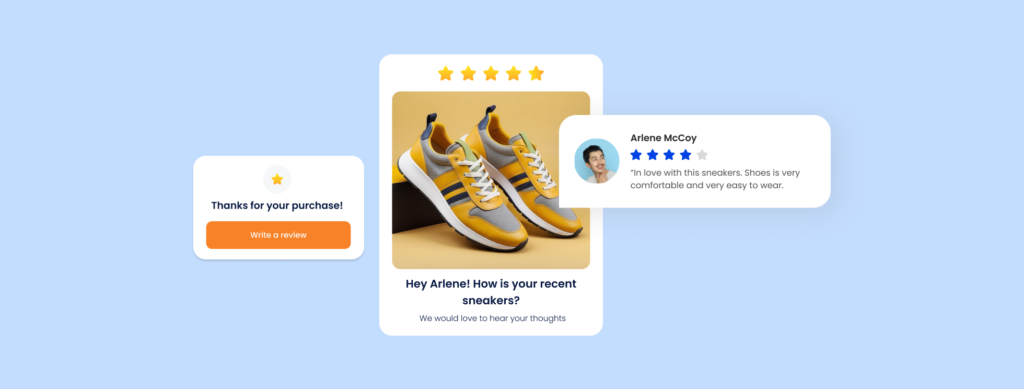Customer reviews and rewards programs are essential for how customers engage with businesses and help them succeed. With digital platforms and social media on the rise, reviews and rewards have become vital for a retail business’s marketing and customer retention.

This document explains why reviews and rewards are important, highlighting their effect on customer choices, brand loyalty, and overall business success.
The power of customer reviews
Building trust and credibility
Customer reviews are crucial for building trust and credibility in retail businesses. With numerous choices available, reviews serve as proof from others, offering potential customers a glimpse into real experiences.
Positive reviews can significantly increase a business’s reputation, whereas negative feedback provides valuable insights for improvement. Most of the shoppers check online reviews before buying, underscoring their impact on purchasing choices.

Enhancing visibility and SEO
Reviews also help improve a business’s online visibility. Search engines like Google take customer reviews into account when ranking websites. Businesses with more positive reviews are more likely to appear at the top of search results, driving more traffic to their websites.
Moreover, reviews often include keywords that improve search engine optimization (SEO), making it simpler for potential customers to discover the business online.

Influencing consumer decision-making
Reviews strongly influence consumer decisions. Honest and detailed reviews give potential buyers the information they need to make smart choices. They provide insights into product quality, customer service, and overall satisfaction, guiding consumers in their purchase decisions.
The role of rewards programs
Encouraging customer loyalty
Rewards programs are an effective way to encourage customer loyalty. By offering incentives such as discounts, points, or exclusive offers, businesses can motivate customers to return and make repeat purchases.
A well-designed rewards program not only keeps customers coming back but also increases their lifetime value to the business. Many consumers are more likely to continue doing business with brands that have a loyalty program.

Driving sales and revenue
Rewards programs can also boost sales and revenue. By incentivizing purchases, these programs encourage customers to spend more to earn rewards. This can lead to higher average transaction values and overall sales volumes. Additionally, rewards programs can be tailored to promote the purchase of specific products or services, helping businesses meet their sales goals.
Gathering valuable customer data
Implementing a rewards program allows businesses to gather valuable data on customer preferences and buying habits. This data can provide insights that help businesses tailor their marketing efforts, personalize customer experiences, and develop targeted promotions.
Synergy between reviews and rewards
Enhancing the customer experience
Combining reviews and rewards can greatly Improve the customer experience. Positive reviews attract new customers, and rewards programs keep them coming back.
Encouraging happy customers to leave reviews and join rewards programs creates a cycle of engagement and satisfaction. This not only boosts customer retention but also builds a community of loyal customers who support the brand.
Building a strong brand reputation
A combination of positive reviews and a compelling rewards program can help create a strong brand reputation.
Happy customers who leave positive reviews and take part in rewards programs are likely to share their experiences with others, both online and offline. This word-of-mouth promotion can increase brand visibility and credibility, attract new customers, and strengthen the brand’s market position.

Leveraging technology for maximum impact
To maximize the benefits of reviews and rewards, businesses can use automated systems to prompt customers to leave reviews after purchases. Platforms like Kasplo can simplify managing loyalty programs, making it easy for customers to track and redeem their rewards.
Integrating these technologies with customer relationship management (CRM) systems can offer a smooth experience for customers and provide valuable insights for businesses.
Best practices for implementing reviews and rewards
Soliciting and managing reviews
To effectively solicit and manage reviews, businesses should:
- Encourage reviews: Prompt customers to leave reviews through follow-up emails, purchase receipts, or in-store signs.
- Respond to reviews: Engage with customers by responding to their reviews, both positive and negative. This shows that the business values customer feedback and is committed to improvement.
- Highlight positive reviews: Showcase positive reviews on the business’s website, social media, and marketing materials to build credibility and attract new customers.
Designing an effective rewards program
To design an effective rewards program, businesses should:
- Understand customer preferences: Tailor the rewards program to meet the preferences and needs of the target audience.
- Offer valuable incentives: Provide rewards that are genuinely valuable to customers, such as discounts, exclusive offers, or free products.
- Simplify participation: Make it easy for customers to join and participate in the rewards program by minimizing complexity and ensuring a user-friendly experience.
- Promote the program: Actively promote the rewards program through various channels, including in-store signs, email marketing, and social media.
Integrating reviews and rewards
Combining reviews and rewards can be a great boost for retail businesses. For instance, businesses can give customers reward points for leaving reviews. This not only gets more reviews but also gets customers more involved with the reward program.

Plus, showcasing positive reviews in ads and promotions can encourage more people to join the reward program.
Conclusion
Customer reviews and rewards programs are important tools for retail businesses that want to succeed in a competitive market. Reviews help build trust, increase visibility, and influence consumer choices, while rewards programs encourage loyalty, drive sales, and provide valuable customer information.
By using both reviews and rewards, businesses can create a great customer experience, build a strong brand reputation, and achieve lasting growth. In a time when customer experience is crucial, incorporating reviews and rewards into retail strategies is not just helpful—it is necessary for success.


